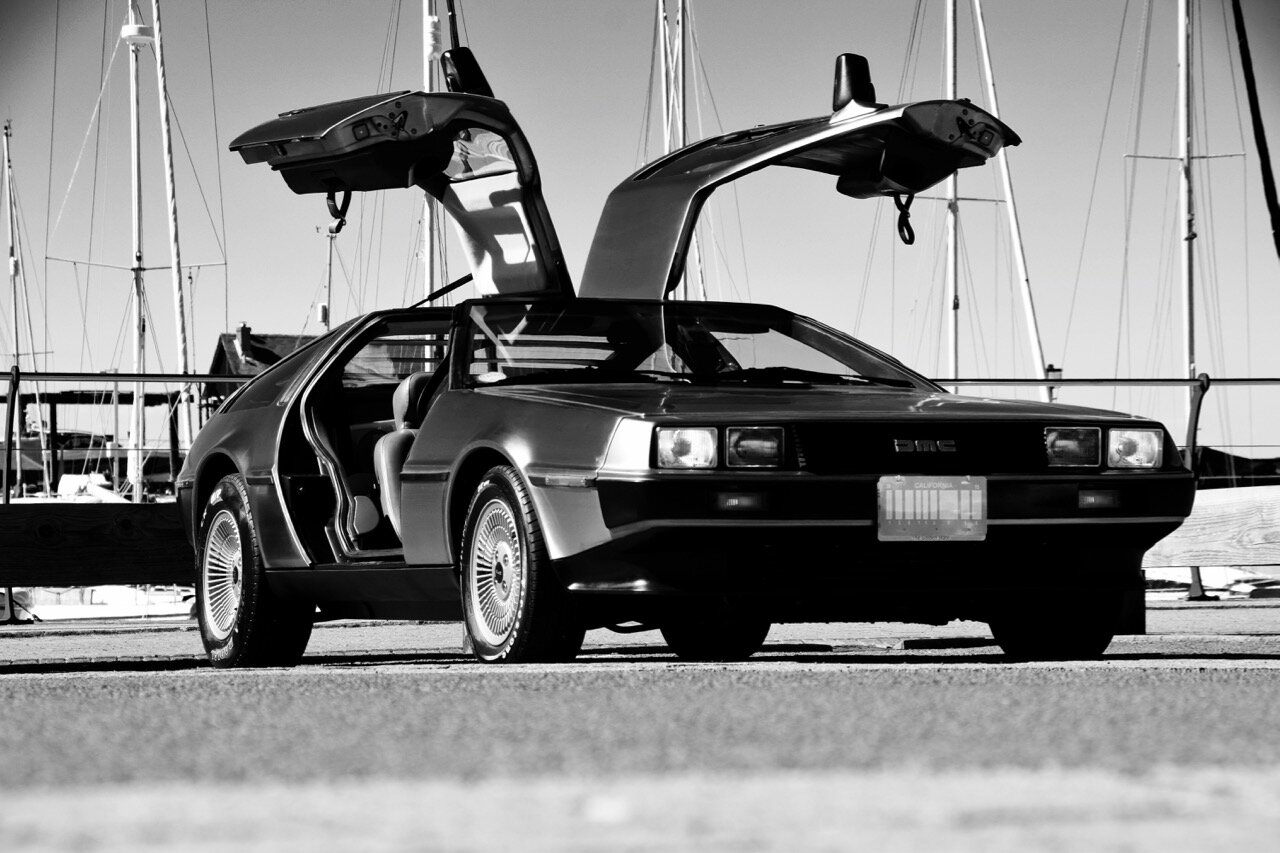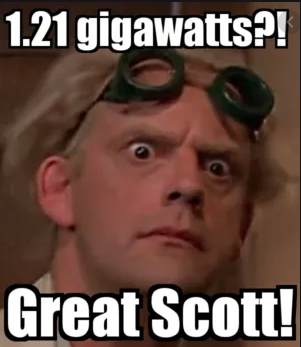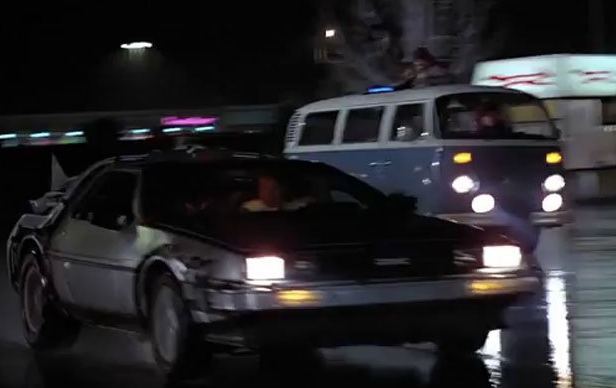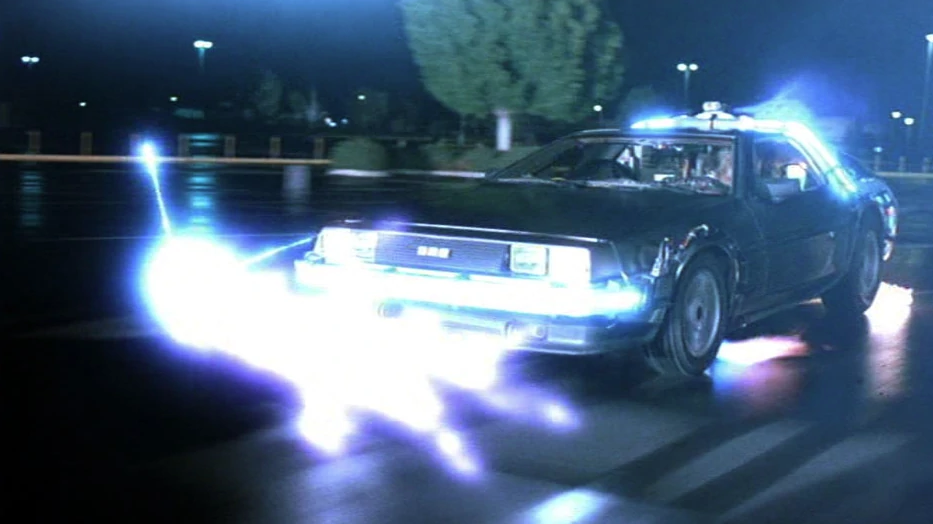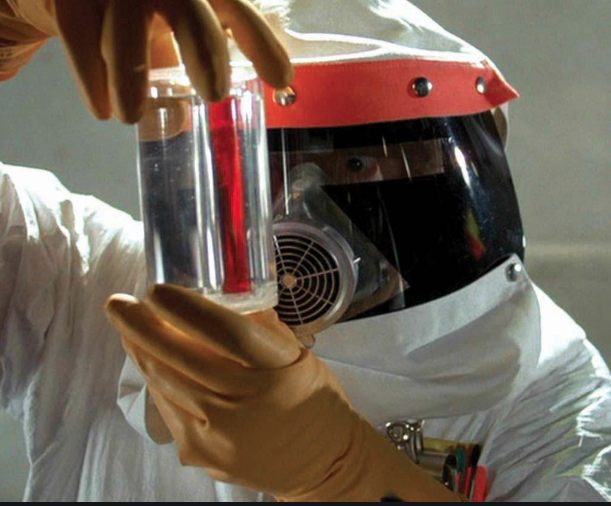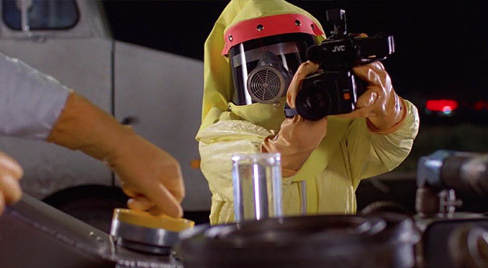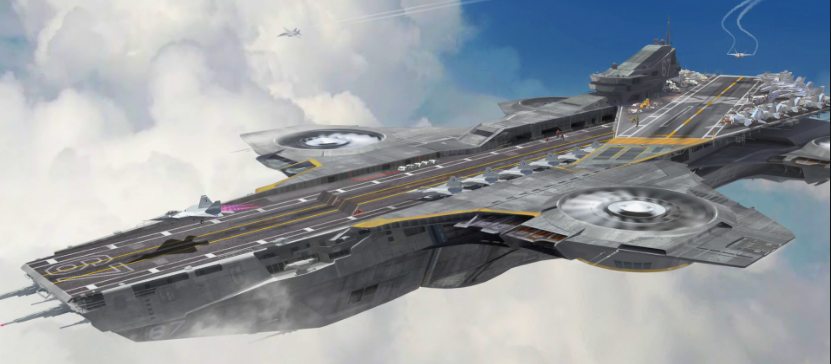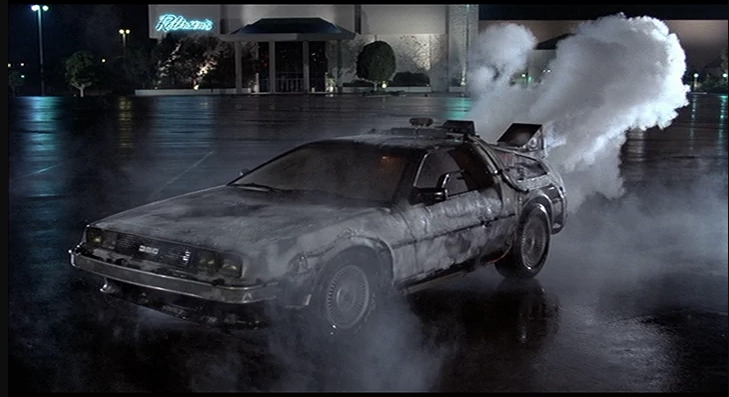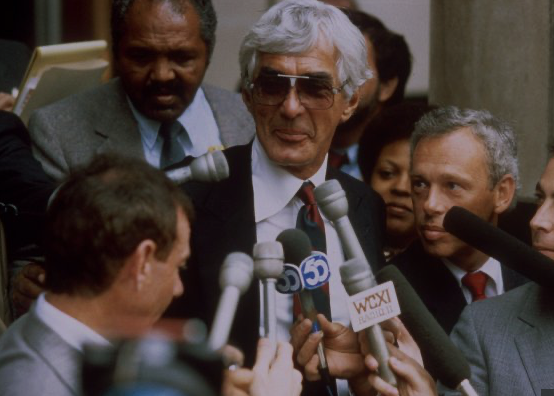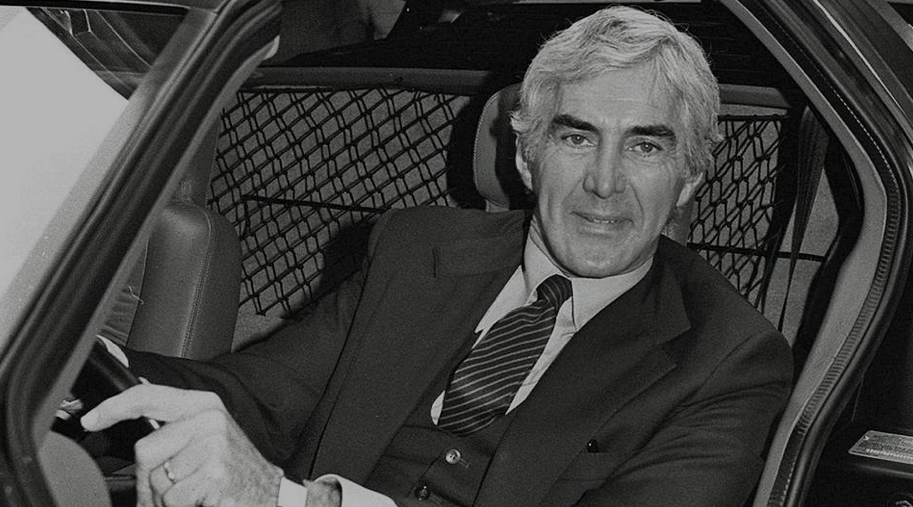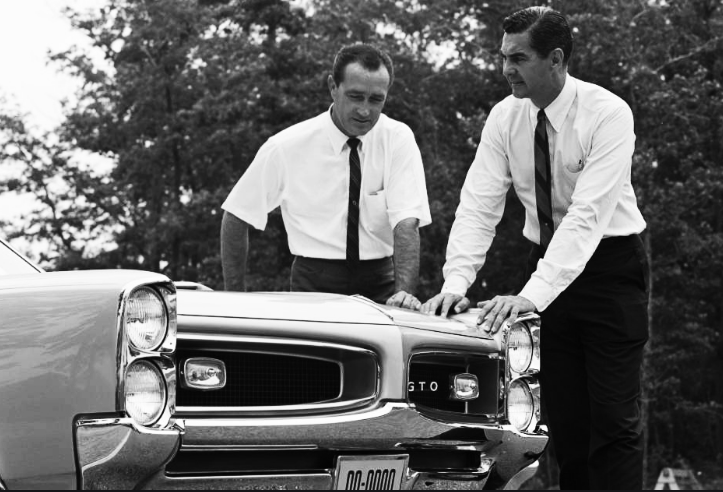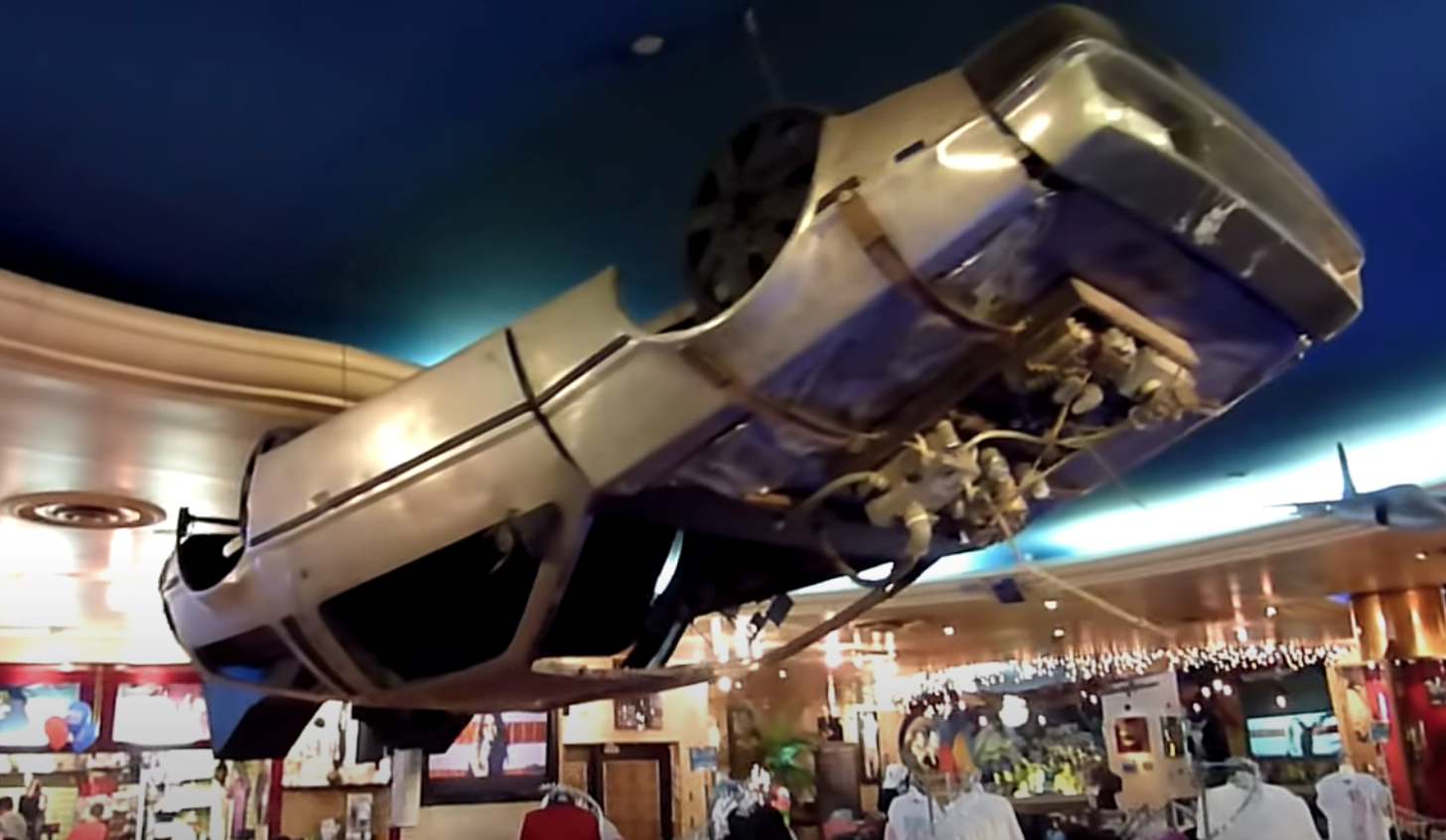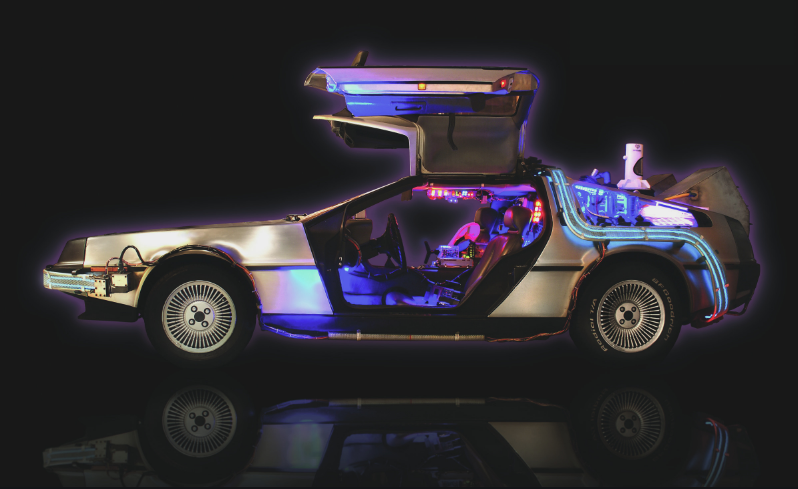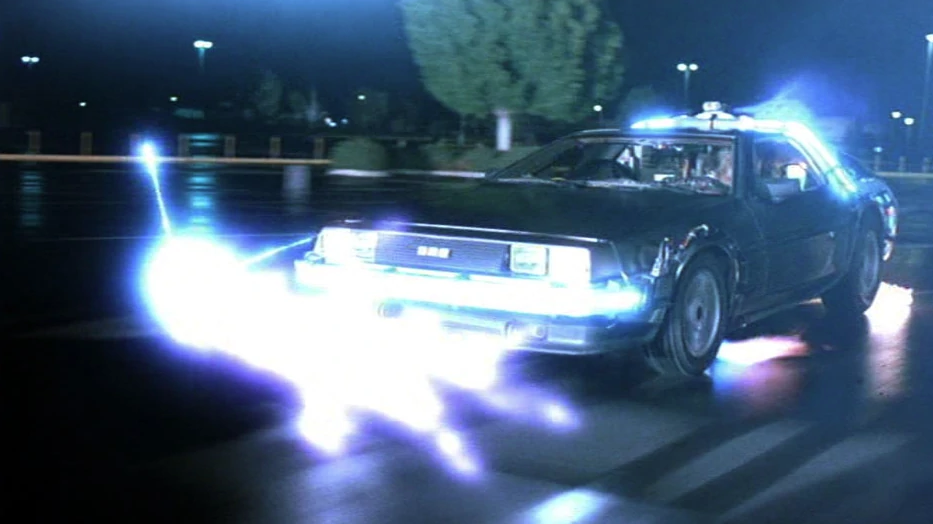
DeLorean Motor Company - Why did it Fail ?
Why did DeLorean Fail ? The answer is more complicated than some may think, and looking at the factors involved the DeLorean Motor Company it certainly had more than it’s fair share of problems… Here’s the Answer …..
Why did DeLorean Fail ? ……
The answer is more complicated than some may think, and looking at the factors involved the DeLorean Motor Company it certainly had more than it’s fair share of problems.
One thing to bear in mind before we get started here, is that John Z Delorean accomplished something still to this day could never be replicated again (and this was in 1978). In that he constructed an brand new assembly 66,321sqm Plant, hired a management team / supporting staff, trained a workforce of 2300 to build a unique Stainless Steel Sports Car within 28 months.
DMC Factory - Northern Ireland
At the time (1978) Porsche said it would take 7 years to design and build a brand new car, Ford said it would take them 5 years (Even with all the Design, Manufacturing, Supply, Staff and Production already in place…….
1974 DMC Incorporated - 1975 - Design placed with Giorgetto Giugiaro - 1977 First Prototype - 158 Investing Dealers - 1978 Funding Secured (after just 45 days) - 02.10.1978 Factory Groundbreaking started with the first DeLorean rolling off the line 21.01.1981 with the shipment of cars leaving from the factory on 20.02.1981.
DMC’s funding was exhausted as the 1st car rolled off the line, Sales were paramount. So no time was left to fully test the car / rectify and correct any factory production techniques before it was shipping. Of course this lead to many high profile and famous people receiving the first cars with production faults, bad press quickly sprea, the cars were returned to Dealers and and so the story begins …….
Why did DeLorean Motor Company fail ? here are some of answers are here …...
Taking you Back to January 1982
DMC was promised government funding after the 1st car rolled off the Production line (£21 Million) which never happen, as Margret Thatcher had come into power, she had been incorrectly advised of the funding required for DMC, so without further investigation or talks said no more British funding.
Celebrating the DeLorean
U.S dragged into recession, the worst since the 1970 fuel crisis, hitting car sales hard
Snowing in U.K but worse in North East of the United States (DeLorean’s only export market) experiencing its worse storm in modern history = no one buying cars
DMC used GM, Ford, Chrysler and European dealerships to sell their cars. But with dealerships needing to preserve their own cash flow, they concentrated on higher volume cars. So single figure sales for DeLorean were not a priority, so got pushed to one side.
Secret shopper tapes revealed dealerships knew very little about lead times, stock for sale, or details of the car, leading to poor sale technique/ no sales.
A strike on January 11th by Shipping workers between British and Northern Ireland caused supply problems, so workforce put on short time
Factory suffered (accidental) damage caused in the hunger riots which totally destroyed Design blueprints, and all factory worker records
£14 million compensation claim submitted by DCML (for insurance damaged caused to the factory by hunger strike riots) was never paid to DMC from the Department of Commerce.
Tough months ahead on cash flow for DMCL
DMCL had a credit line of $30 Million with the Bank of Americas. This covered the cars during transit – Export carparks were nearly full, so they neared credit limit
Deloreans awaiting sale
Suppliers asked to provide extra credit, as funding was so low
This coincided with the last 2 shipments of 1075 cars ($22 million dollars worth) being released without being covered by the Bank of America, meaning that inward cash flow had dried up.
DMC was also obliged to pay the British government £185 (nearly $400) for each car sold, cutting into the company’s per-car margins.
John Z DeLorean
DMC American could not pay the $22 million to DCML for the stock exported as sales had dried up throughout network.
Week 3 - January with Bank of America Credit line exhausted, on the 28th they withdrawn export cover
1100 of the 2600 (mainly 2nd shift) made redundant, with C.P Trim reduced to 1 day a week
DeLorean Factory
8,580 Cars made up to receivership on 19.02.1982
9,080 Cars made in total up to February 1983
One question remains did DeLorean really fail ?
Well 40 years on and the ‘Dream’ is still alive, maybe the Back to the Future film did move the spotlight from the amazing accomplishments of the 2500 Dunmurry Northern Ireland Factory workers.
But it firmly fixed the DeLorean as one of the most Iconic movie cars of all time.
John DeLorean’s original concept was to build a car :
That was instantly recognisable and the test of time this is still true today whether your young or old - Yes
A Dream Sports Car that lasted as long as the owner wanted to keep it - Yes
To ‘Live the Dream’ - Yes, (maybe not in the way John Z DeLorean imagined) but 40 years on the car is being kept alive by the owners, along with the backup of full dealer services by DeLorean Motor Company operating today in Texas, Florida, Midwest, California, U.K - Yes
Build a car that will never rust - Yes
A unique Iconic car - Yes
John DeLorean with Cristina Ferrare
Perhaps that’s the ultimate tragedy of DeLorean
The car - The Company - The Man
Is that it’s not how far they fell, but how much higher they could have climbed ……
Follow our Hashtags …..
#DMC #Deloreanmotorcompany #johndelorean #johnzdelorean #whydiditfail #dmc-12 #jzd #thecompany #carproduction
www.sandstoneproductions.co.uk
To find out more fun Future Facts by clicking our Blogs below……….!!! Please Share …..
Ghostbuster - Ecto 1
https://www.sandstoneproductions.co.uk/blogtothefuture/2021/3/31/ghostbusters-ecto-1
Cars of Back to the Future
https://www.sandstoneproductions.co.uk/blogtothefuture/2021/2/10/the-cars-of-back-to-the-future-55-
Back to the Future Fashion
https://www.sandstoneproductions.co.uk/blogtothefuture/2021/2/19/back-to-the-future-fashion-te2yx
Ariel Leader
https://www.sandstoneproductions.co.uk/blogtothefuture/2021/2/17/ariel-leader
Back to the Future - Hill Valley History
https://www.sandstoneproductions.co.uk/blogtothefuture/2021/2/2/hill-valley-history-jxrr4
Back to the Future Gadgets and Trends we have in 2021
Doc Browns Biography and the History of his DeLorean Time Machine
Marty McFly Biography also featuring Biff, George, Jennifer, Loranine
Back to the Future - Hill Valley History
https://www.sandstoneproductions.co.uk/blogtothefuture/2021/2/2/hill-valley-history
Back to the Future - Detailed storyline
Back to the Future - How to generate 1.21 Giggawatts / Jiggawatts with Mr Fusion
What is a Fat Bike ? And where did the idea of Fat Bikes come from ?
https://www.sandstoneproductions.co.uk/blogtothefuture/2021/1/10/fat-bike-what-is-a-fat-bike-history
The Time Paradox explained - Back to the Future
The Sinclair C5
https://www.sandstoneproductions.co.uk/blogtothefuture/2021/1/9/sinclair-c5-
Mini Jeep Mini Review
https://www.sandstoneproductions.co.uk/blogtothefuture/minicoolsterjeepreview
Hoverboards - Back to the Future
https://www.sandstoneproductions.co.uk/blogtothefuture/2020/12/13/hoverboards-
How does the Time Machine work - Back to the Future
https://www.sandstoneproductions.co.uk/blogtothefuture/2020/11/22/how-does-the-time-machine-work
The DeLorean Motor Company - What did it fail ? Or did it ?
https://www.sandstoneproductions.co.uk/blogtothefuture/2020/11/22/whydiddeloreanmotorcompanyfail
The DeLorean Motor Company - History
https://www.sandstoneproductions.co.uk/blogtothefuture/2020/11/22/deloreanmotorcompany
The Flux Capacitor - Back to the Future
https://www.sandstoneproductions.co.uk/blogtothefuture/fluxcapacitor
Is Time Travel Possible ? And what would it take ? Back to the Future
https://www.sandstoneproductions.co.uk/blogtothefuture/istimetravelpossible
Great Scott !!! How to generate 1.21 Giggawatts (Jiggawatts) with Mr Fusion ...... in the DeLorean Time Machine
Sending you Back to the Future ! But how could Doc Brown invent, design, and build a Time Machine out of a DeLorean ? …. And could it be possible in the Future ? We explore the science behind this amazing Si/Fi Stainless Steel Car
We all know what Doc Brown said in the first movie.
"I need a nuclear reaction to generate the 1.21 gigawatts of electricity I need".
Doc Brown
Hill Valley Clock Tower - Lighting strike Credit : Universal Pictures Amblin Entertainment
Your Built a Time Machine ….. Out of a DeLorean ! ….. We explore the science behind Doc Browns amazing Time Machine, starting with what is 1.21 Gigawatts and how can you generate that kind of Power …….
Great Scott! Marty: What? What the hell is a gigawatt?
1.21 Gigawatts was pronounced (on set) as it were spelled with a "j", as in jigawatts (or jigowatts)..
So, how much is 1.21 gigawatts you ask?
Well, a gigawatt is equal to one billion (10 9) watts or 1 gigawatt = 1000 megawatts.
A watt is a unit of power.
Your typical 100 watt incandescent light bulb draws 100 watts of energy, so 1.21 gigawatts would be able to light over 12 million 100 watt light bulbs. 1.21 gigawatts is also equivalent to 1,621,400 horse power
How does the plutonium in the BTTF car generate 1.21 gigawatts in less than a couple of minuets?
Well the meaning of power (the watt is a unit of power). Power refers to the rate at which energy is produced. Power can be one of several things. The most often way to describe it is the change in energy in a certain amount of time.
1 watt = 1 joule per second where a joule is a unit of energy. Horsepower is another unit of energy where 1 hp = 746 watts.
(roughly equivalent to the amount of energy it takes to lift a medium large apple 3 feet)
If energy is measured in units of Joules, and the time interval is in seconds the power would be in Watts.
What about the giga? Giga is a prefix for units that typically means 10 to the power of 9.
This means that 1.21 gigawatts would be 1.21 x 10 to the power of 9
This means producing a given amount of power in a limited amount of time is not an important problem.
If you have a battery that can store only 1 joule of energy : but will discharge in a nanosecond the power output will be a gigawatt, but only for that nanosecond.
A large marine battery can store 8 megajoules and could theoretically produce 1.21 gigawatts for .066 seconds.
Nowhere in the movies is it stated for how long the 1.21 gigawatts needs to be produced, but we can estimate an upper limit based on the properties of lightning.
A typical bolt of lighting contains about a gigajoule of energy and lasts for .2 seconds.
The dynamics of how the lightning was used to power the flux capacitor indicates that it was directly powered by the lightning and no storage battery was involved. We can therefore deduce that the maximum energy needed to create a temporal shift is 1.21 gigajoules/sec X .2sec = 242 megajoules.
We now have two ways to power the flux capacitor:
The Flux Capacitor Credit : Universal Pictures Amblin Entertainment
1) Feed it directly from gigawatt capable generator or
2) Use a lower power generator to charge up a 242 megajoule battery.
A currently available 242 megajoule battery weighs a little over 200 pounds and is the size of a standard blue home recycling bin.
While this type of battery is not rechargeable and cannot deliver all of it’s energy in .2 seconds it gets us in the ballpark of what is needed.
On the other hand there are no gigawatt generators currently available that could fit in a container sized truck , much less a Delorean.
We therefore conclude that in standard mode the flux capacitor is battery powered for the .2 seconds or less it is in use and the plutonium generator does not need produce 1.21 gigawatts.
A micrometer-sized circulators that can be fabricated on a microchip.
We figured out how to integrate magnetic flux quanta — the smallest units of magnetic field — with microfabricated capacitors and other superconducting circuit elements, so that time-reversal symmetry can be broken.
This led to our new circulator proposal. As with conventional circulators, there is a magnetic field present. But because we can use just one magnetic flux quantum, our design can be microscopic.
See the design similarity: (left) the fictional flux capacitor from the movie and (right) a schematic representation of the proposed circulator. Tom Stace/Screenshot from Back to the Future, Author provided
We’ve nicknamed the device the quantum flux capacitor as its circuit diagram has a passing resemblance to Doc Brown’s mythical invention (which are for sale, sort of).
Sadly for history buffs, our design won’t help much in your DeLorean time machine: it doesn’t reverse time. But its magnetic field does break time-reversal symmetry as advertised and we expect these devices will find applications in future quantum technologies.
Even sooner, they may help in high-bandwidth communications environments like mobile phone base stations in very dense populations, or for ultra-high sensitivity radar where every photon of the electromagnetic field counts.
www.theconversation.com
Great Scott Doc Brown -
If we allow for a 24 hour recharge time for the battery then the generator only needs a continuous output of 2600 watts. No problem for an eccentric genius.
Paul Grimshaw - IT Architect in the Computer Industry (1983-present)
How many AA batteries would it take to generate the 1.21 gigawatts of electricity needed to send Doc Brown’s Delorean back to 1985?
Let’s see, you can squeeze around 5A at 1V out of a decent NiMH AA cell, so that’s 5W.
To get 1.21GW you would therefore require 242,000,000 cells
NiMH AA batteries weigh around 30g per cell, so 242 million of them would total 7,260 tonnes!. With cabling that’s around the weight of a modern Navy Destroyer ship.
AA batteries are 14mm diameter and 50mm long. Allowing a little room for cabling, you can squeeze 100 batteries in 1000 cubic cm (1 litre).
So for 242,000,000 cells you would need 2,420 cubic metres. That’s about the size of 10 double decker buses.
So probably not the most practical of options.
Instead, ironically, capacitors would be a much better idea for powering a flux capacitor.
The Flux Capacitor
Not just any old capacitors, but some of the capacitors capable of outputting the highest powers as listed here:
SERIES CMX - Self-Healing Energy Storage Capacitors
The 3330CMX2205 looks particularly suitable, each one capable of outputting 100,000A at 3,300V.
So just four of these could generate a colossal 1.32GW - that’s more than enough to send Doc to 1985 AND power his heated car seats at the same time.
Weighing in at 49kg each, four of these capacitors weigh a mere 196kg - let’s round up to 200kg with some mounting brackets. Spacewise, the bank of four capacitors occupy 0.66 x 0.41 x 0.56m, so these would fit comfortably in the trunk, with room for a set of golf clubs to spare.
Did anybody spot the name of the capacitor manufacturer in the link? Yep, it’s General Atomics. So it may not be Plutonium, but it’s still Atomic powered!
Just the job. To be fair, these capacitors can only output this level of power for a fraction of a millisecond, but I’m pretty certain that’s more than enough time to get back to 1985 as long as the car is going fast enough.
Also they would be ideal for recharging by lightning ready for the trip back. As you can see in the picture, they even have a convenient warning on the front not to handle the lightning whilst it’s running through the cable.
On a slightly more serious note, capacitors are commonly used to provide very high power short duration energy bursts. One example is at the US National Ignition Facility, where they have 4,000 capacitors similar to those above, in this case to power their laser.
The energy stored is again released in a fraction of a millisecond, but this time at a power exceeding 1 TeraWatt. That’s a thousand times that used by Doc, and it exceeds the peak electricity demand of the entire US.
Scott Soloway - Degree in math and physics but majored in pinball
Paul Grimshaw - IT Architect in the Computer Industry (1983-present)
The lower thrust fusion rocket produces 187.1 GW of power. Ten of these plants would power all industry on Earth.
How Do You Get 1.21 GigaWatts For Your Time Machine?
DeLorean Time Machine
Nizmitz Class Aircraft Carrier
Is that a large amount of power?
Yes. Just for comparison, the nuclear power reactors in a Nimitz Class Aircraft Carrier produces 194 megawatts (1.94 x 108 watts).
Or perhaps you would like to compare this to the flying S.H.I.E.L.D. Helicarrier. With my calculations, I get a power requirement of 317 gigawatts.
S.H.I.E.L.D Helicarrier
First look at the DeLorean Time Machine Credit : Universal Pictures Amblin Entertainment
What Does Doc Brown Even Mean?
How much power does it take to travel through time?
Well, Doc said 1.21 gigawatts.
If I want to calculate the energy required for time travel, I will need the power (given) as well as the time.
How Long Does it Take to Travel in Time?
That's actually looks like a stupid question. Oh well. Let's take a look at the actual real life footage of the time machine (from the historical archives).
Time travel is possible if you get the car up to 88 mph.
Is this car going 88 mph? Is there any way to tell? Oh, yes. Yes, there is. All I need to do is to look at this car (a DeLorean) and use – video analysis. The clip isn't perfect, but I think it will give a good enough estimate. I can scale the video using the wheel base of 2.413 meters.
Time Machine being chased by VW Camper Van in Twin Pines Mall Credit : Universal Pictures Amblin Entertainment
Here is a plot of the position of the DeLorean in the first time travel (with the dog in the car).
The slope of this line puts the car's speed at 56.7 m/s (127 mph). Yes, that is faster than 88 mph. I'm not sure why the one frame repeated. Also, there could be a problem with my scale since it was rather difficult to see the car. Here is the next time the car gets to a speed near 88 mph (when Marty first goes back in time).
DeLorean Time Machine - Flux - in Twin Pines Mall Credit : Universal Pictures Amblin Entertainment
DeLorean being struck by lighting Credit : Universal Pictures Amblin Entertainment
Well that's not good. This give a speed of 29 m/s (65 mph). For this video, the car isn't quite up to 88 mph so this seems ok. I guess I should look at the last time travel speed (when Marty goes BACK TO THE FUTURE). Oh, actually there is not a good shot to analyze there. Oh well, the second shot is close enough to 88 mph, that I will just stick with that.
What about the time interval? For the first test, I looked at the time from just when the car started to shoot sparks until it "exploded".
This gives a time of 4.3 seconds. But wait !
What about the case when a lightning bolt is used to power the car? For that case, the time machine is only getting power for at most 0.46 seconds. So, there are two different time intervals for two different trips through time.
Time Travel Energy
Now that I have the power AND the time, I can calculate the required energy. Let's just do it (for both time interval estimates).
That's not so bad. I have an energy range with the high end just a factor of 10 higher.
Now, how do you get 5 x 108 - 5 x 109 Joules?
Doc Brown's first choice was to use plutonium. Although he didn't give too much of the details, I guess he was using Plutonium-239. Pu-239 is radioactive, but I don't think that's how it gave energy in this case.
Instead, I guess that there was some type of fission process that broke the nucleus into smaller pieces. Since the pieces have less mass than the original, you also get energy (E = mc2). The Wikipedia page on plutonium as the details, but let's just say that one Plutonium atom produces 200 MeV (mega electron volts) in the fission process (3.2 x 10-11 Joules).
Doc Brown refuelling the DeLorean Time Machine Credit : Universal Pictures Amblin Entertainment
Doc Brown Plutonium Case - Credit : Universal Pictures Amblin Entertainment
In a typical nuclear reactor (which probably wouldn't use Plutonium-239), this energy is used to increase the temperature of water to make steam. The steam then turns an electric turbine to produce electricity. Clearly, that's not happening here. I'm not sure what's going on - but surely it's not a 100% efficient process. I am going to say it's 50% efficient.
In order to get 5 x 108 Joules, I would need:
Since 1 Plutonium-239 atom has a mass of 3.29 x 10-25 kg, this would require a fuel mass of just 1.2 x 10-5 kg. That seems possible.
What about a lightning bolt? Could you get this much energy from lightning? According to Wikipedia, a single bolt of lightning can have about 5 x 109 Joules. That would be just perfect for the time traveling machine.
Refuelllng the DeLorean Time Machine Credit : Universal Pictures Amblin Entertainment
Hill Valley Clock Tower being stuck by lighting Credit : Universal Pictures Amblin Entertainment
But what if lightning & Plutonium for an energy sources are just difficult to get hold of ?
Maybe batteries would be an interesting way to power this machine.
How many AA batteries would you need? From a previous post,
I already know that a high quality AA battery has about 10,000 Joules of energy. In order to get 5 x 108 Joules, I would need 5 x 104 AA batteries. Of course, that assumes that I could completely drain these batteries in just half a second. Damn, those things would get hot.
AA Batterys
Homework
Clearly, there are other questions. Here are some that I can think of.
How much space would a DeLorean need to get up to 88 mph? You can look up the time for it to get from 0-60 mph and assume that it has a constant acceleration.
At the end of Back to the Future, Doc Brown replaces the Plutonium energy source with a Mr. Fusion. Estimate how much energy he could get from a banana peel.
Mr Fusion Fuel Credit : Universal Pictures Amblin Entertainment
· If you watch all three movies in the Back to the Future series, there are several times that the car gets up to 88 mph. Use video analysis to check the speeds.
·
How long would it take current from the lightning strike to travel from the clock tower to the car?
·
Suppose that Marty is 1 second late on his start to get to the lightning wire. How much greater of an acceleration would he need to make it to the wire on time (assuming that over 88 mph works just as well as 88 mph)?
·
What if there wasn't a known source of lightning? What other ways could Doc get energy to power the DeLorean in 1955 (or whatever the year was)?
·
Assume that the energy needed to time travel was directly proportional to the mass of the object. Would the S.H.I.E.L.D. Helicarrier have enough power to go back to 1957?
Pushing the DeLorean to 88mph Credit : Universal Pictures Amblin Entertainment
S.H.I.E.L.D - Helicarrier
Carmen Drahl Former Contributor Science
Wheres Mr Fusion ?
To get some answers, I spoke with Egemen Kolemen. He’s a specialist in the control of fusion plasmas at Princeton University, where he is an assistant professor with joint appointments at the Andlinger Center for Energy and the Environment, the department of mechanical and aerospace engineering, and the Princeton Plasma Physics Laboratory.
Egemen Kolemen, Princeton University (Credit:
Our Q&A is below, and is lightly edited for clarity.
Carmen Drahl:
Thanks for talking futuristic fusion with me, Dr. Kolemen!
In Back to the Future, the central time travel device was originally powered by plutonium, but this was replaced by the Mr. Fusion reactor.
Mr Fusion Home Energy Reactor Credit : Universal Pictures Amblin Entertainment
What’s the difference between how radioactive plutonium might generate electricity and how a fusion reactor would?
Egemen Kolemen: Radioactive plutonium produces energy by splitting up to smaller elements, which is known as the fission reaction.
In a fusion reactor, we combine small nuclei to make energy. Soon enough, we hope to move from fission to fusion technology just as Back to the Future II predicted.
This would help Doc Brown avoid troubles with the terrorists in the original movie— we use water as fusion fuel and you cannot make an atomic bomb with water!
CD: Mr. Fusion was able to generate power from household garbage— a banana peel, Miller beer, and even a beer can! What are the typical starting materials that are used in fusion reactors today?
EK: We use isotopes of the element hydrogen (known as deuterium and tritium) in current fusion reactors. There is enough heavy hydrogen fuel in sea water, H2O, to fuel the world’s energy needs for billions of years.
CD: In theory, could Mr. Fusion have been generating power by fusing together several different atoms or isotopes contained inside the garbage?
Mr Fusion ReFuelling
Or could the reactor only work by fusing deuterium and tritium in the garbage? In other words— could you generate energy from fusing many different nuclei?
EK: Theoretically, fusing elements lighter than iron releases nuclear energy. If a clever physicist could overcome the engineering problems, a machine like Mr. Fusion could physically make energy by fusing banana or beer which mostly consists of carbon, oxygen and hydrogen. (It would even work for a beer can made of aluminum!). This is the process that happens in the core of large stars which is the birthplace of all the heavy elements in the universe.
Time Machine refuelled
However, as the elements get heavier, the fusion process gets harder and requires more energy to initialize and becomes less economical. That is why we use the isotopes of hydrogen, the lightest element in the universe.
Mr Fusion
There is no physics reason why you could not fuse many different nuclei.
Stars fuse many different elements with each other.
However, just as cars are designed to run with only one specific type of fuel (gasoline, diesel, etc.) to make them more efficient and economical, fusion reactors that work on preset fuels would be cheaper and an easier engineering challenge.
CD: Mr. Fusion was the size of a coffee maker.
That’s pretty tiny compared to the typical fusion reactor—
the experimental reactor being built in France will be over 5000 tons!
What are the challenges to making fusion reactors small?
EK: The fusion process happens when two particles hit each other each other at high velocity inside the reactor.
So, the energy production in a fusion reactor grows roughly in proportion to the volume (or the number of particles inside) of the reactor.
At the same time, the energy loss occurs mostly due to the drifting particles out from the surface of the reactor. As the reactor size gets bigger, volume which grows roughly as the cube of the radius increases much faster than the surface which grows as the square of the radius.
As a fusion reactor gets bigger the ratio of energy production to losses increases making it easier to produce net energy.
We use very strong magnetic forces to be able to confine the deuterium, tritium and electrons inside the reactor. If one can build superconducting coils that can produce much stronger magnetic fields (i.e. a stronger trap) than the ones available today, a smaller machine might be possible. This is an active research topic!
Interior of the National Spherical Torus[+]
CD: We’ve all seen car engines malfunction. Could Mr. Fusion explode in a mushroom cloud destroying everything in a 250 mile radius if something went wrong?
EK: Fusion is a delicate process that needs constant control. Unlike fission reactors, fusion cannot have a runaway chain reaction. If the “engine” malfunctions, the fusion process would stop immediately. So no explosion is possible. That is one of the many advantages of fusion energy.
CD: Mr. Fusion would have to be doing hot fusion, because cold fusion is a myth, right?
EK: There is no scientifically known net energy-producing cold fusion reaction.
CD: So since you do have to heat your starting materials to extremely high temperatures to achieve fusion, how cool can we make the outside of a fusion reactor—cool enough to safely attach to a vehicle?
EK: The wall inside the fusion vessel would be hot just as the inside of the car engine. However, the reactor would have a cooling system, similar to the radiator in a car, making the outside of the reactor at room temperature. The reactor would be as safe as the car engine.
CD: We still haven’t passed the break-even energy point in nuclear fusion— where we get more energy out of fusion than we had to put in. What gives you reason to think we’ll get there?
EK: We have been running experiments on many different fusion reactors all around the world and comparing the experimental data we obtain to computed simulations of the physics process.
We have been upgrading our simulation capabilities using new numerical methods and tools and checking against the experimental data.
At this point, we can reproduce and predict experimental outcomes in existing fusion reactors. We believe that our understanding of the physics and capability to simulate processes are advanced enough to roughly predict how a reactor will behave.
Based on this understanding, we designed the ITER (International Thermonuclear Experimental Reactor) nuclear fusion reactor. ITER is under construction under an international collaboration, and it is expected to come online in a decade.
We predict that we will obtain 10 times more fusion energy output as the power we put in. As with any research, we can only know the exact answer after running the machine but we try to do our best to predict the reactor behavior.
CD: Thank you for your time, Dr. Kolemen!
Follow me on Twitter.
I'm an independent journalist specializing in chemistry, in particular the places where chemistry meets biology. I was a staff science writer at Chemical & Engineering…Read More
As a renewable energy source, cold fusion is potentially unlimited clean energy. But what is fusion energy, how does it work, and is there such a thing as cold fusion?
You may have heard about cold fusion, the idea that atoms can be fused together without using any significant heat or other type of energy and yet producing a great deal of energy.
This philosopher’s stone has been the object of the quest of many a modern-day alchemist, so we shall leave it to them.
Hot fusion, however, is real. It’s what happens inside the sun and other stars. Nuclei of atoms crash into each other at great speed, resulting in fusion and a great deal more energy released. Research and development into fusion energy is trying to create similar reactions here on Earth at over 100 million degrees Celsius.
The opposite of nuclear fission
Fusion energy, in a way, is the opposite of what we conventionally call nuclear energy – although fusion energy also deals with the nucleus of atoms. In current nuclear power plants, the energy comes from splitting the atom.
Fusion, as the name suggests, produces energy not by breaking atoms apart, but by fusing them together.
The real difference comes from the kind of elements involved in these processes. What we know as nuclear energy requires elements with big, heavy atoms like uranium or plutonium that can be split into smaller atoms.
However, uranium, plutonium, and their fission products are radioactive, which means that when they decay they emit ionising radiation, which in certain circumstances might be dangerous to humans.
Back to the Future Darth Vader Credit : Universal Pictures Amblin Entertainment
Fusion energy instead is based on combining two lightweight atoms – usually hydrogen. When two hydrogen atoms fuse, they create helium.
So not only does fusion energy rely on the most abundant element in the universe, its byproduct can be easily used for medical purposes, or to blow up balloons.
Try pushing two magnets together
How do you fuse two atoms?
The challenge comes from the fact that the nucleus of an atom contains positively charged protons and neutral neutrons, as you will surely recall from your physics class.
Therefore, the nucleus of an atom will always carry a positive charge. Trying to combine it with another one with a positive charge is like trying to push two magnets towards each other. They will resist. This is why fusion energy uses the lightest atoms possible. But it is still very hard.
Inside the sun, fusion occurs because the immense gravity draws atoms together, creating extreme density and enormous heat, which makes the atoms collide with each other at great speed.
The force of gravity is much weaker on Earth, because of the relatively small size of this planet, and the temperature – despite global warming – is nowhere close to the heat of the sun. So how can we create similar conditions here for fusion to occur?
Hotter than the sun
The answer is fairly obvious. To make up for our lower gravity, you simply have to create a temperature hotter than the sun.
Six to ten times hotter, up to 150 million degrees Celsius. Here on Earth this tremendous heat will create the conditions to allow the hydrogen atoms to bump into each other, resulting in fusion and generating even more energy.
Sounds easy? There are quite a few details that need to be ironed out.
First issue: where could you create such a temperature, so that the heated substance wouldn’t destroy everything it touches?
Again, the solution is simple: don’t allow it to come into contact with anything. To achieve this, Russian scientists in the middle of the 20th century developed the tokamak, a chamber the shape of a hollow doughnut, surrounded by powerful magnets.
Inside this chamber, the hydrogen gas is heated to an extremely high temperature and transformed into a plasma state.
The plasma state is one of the four fundamental states of matter, in which the gaseous substance becomes ionised – because electrons orbiting the atomic nuclei are stripped away.
The ionised matter is electrically conductive and therefore the magnetic fields can dominate the behaviour of the matter. That is where the magnets come in.
Magnets can keep this electrically conductive substance from approaching the tokamak’s walls, hovering above it. Inside the plasma, the conditions are suitable for the atoms to bump into each other and to fuse, releasing energy.
The world’s largest experimental tokamak nuclear fusion reactor – called ITER – is under construction in France, to prove the feasibility of thermonuclear fusion as a large-scale and carbon-free source of energy.
ITER is an international research and engineering megaproject involving the European Union, China, India, Japan, South Korea, Russia and the US.
If successful, the facility will turn 50 MW of power inserted into the system – to initially heat the plasma – into fusion power output of 500 MW.
A lot of doughnut
The ITER reactor will be huge:
the ITER tokamak will be as heavy as three Eiffel Towers;
the structure of the 1 000-tonne electromagnet in the centre of the machine must be strong enough to contain a force equivalent to twice the thrust of the Space Shuttle at take-off (60 meganewtons, or over 6 000 tonnes of force);
there will be 18 D-shaped electromagnets around the doughnut-shaped tokamak chamber, each of them 17 metres high and 9 metres wide, weighing 310 tonnes, the approximate weight of a fully loaded Boeing 747-300 aeroplane.
270 million degrees Fahrenheit to ignite fusion—a full ten times hotter than the sun's core.
But how could we get that enormous energy out of the doughnut and safely channel it into our homes as electricity?
This is done via the main chamber wall and a region called the divertor, positioned at the bottom of the tokamak. The divertor controls the exhaust of heat, waste gas and impurities from the reactor and withstands the highest surface heat loads. The surface of the divertor is covered by tungsten, the metal with the highest melting point (3422°C).
In 2019, with the backing of the European Fund for Strategic Investments, the European Investment Bank signed a €250 million loan to the Italian research agency ENEA to help build the divertor and tokamak test facility. The plant will test various alternatives to exhaust the huge amount of heat flowing into the divertor component of a nuclear fusion reactor.
A glorified steam turbine
Researchers continue to look for alternatives, but as it stands now the whole process of transitioning the heat to electric power then becomes rather old-fashioned.
The heat received by the plasma-facing wall and the divertor will be used to turn water into steam, which will drive a steam turbine. divertor, positioned at the bottom of the tokamak“The scientific advances towards fusion energy are not likely to occur like the apple falling on Newton’s head,” says Istvan Szabo, a senior engineer in the European Investment Bank’s energy security division. “You need many more resources.”
Szabo concedes it is possible that tomorrow someone will come up with a completely different solution to harness fusion energy, or a different answer to the need for sustainable energy to power us into the future.
“There are other ideas to compress matter and fuse atoms. For example to use lasers or mechanical compression. And maybe someone will one day solve cold fusion,” Szabo says. “But testing these will all require immense resources.
Thermonuclear fusion is furthest along the research and development phase. It offers the most hope.”
Cold fusion remains elusive—but these scientists may revive the quest
The first public results from a Google-funded project reveal renewed interest in the long-sought but controversial nuclear energy source.
BY MICHAEL GRESHKO
PUBLISHED MAY 29, 2019
Sparking a controversy
Nuclear fusion occurs when pairs of light nuclei fuse together to form a nucleus of net lighter mass, releasing huge amounts of energy as described by Einstein's iconic equation E = mc2.
Inside the sun, hydrogen atoms fuse to produce helium and energy. If successfully harnessed on Earth, fusion could provide humankind with abundant, emissions-free energy—a huge boon to efforts to combat climate change. (As a byproduct, fusion on Earth might also help to address a global helium shortage.)
But getting fusion to work on Earth is tricky, since it's hard to get two nuclei close enough to combine; atomic nuclei are positively charged, so they fiercely repel one another, a hurdle known as the Coulomb barrier.
Crossing this barrier and realizing fusion power is possible at high densities and temperatures, if the nuclei are confined for a sufficiently long time. But to achieve these conditions, scientists seem to need large, expensive machines and huge amounts of initial power.
“What nature does with the enormous force of gravity in the sun's core is what mankind has been trying to do under controlled conditions in the laboratory,” says physicist Amitava Bhattacharjee, the head theorist at the Princeton Plasma Physics Laboratory, one of the leading fusion research groups in the U.S.
“For the last 60 years we’ve been at this, and I think the progress has been enormous,” he adds. “But we still continue to have a challenge to make nuclear fusion power inexpensively available to people.”
But what if cleverly structured materials could somehow lower the energy needed for fusion? That's what chemists Martin Fleischmann and Stanley Pons at the University of Utah thought they had achieved.
On March 23, 1989, University of Utah chemists Martin Fleischmann and Stanley Pons announced their "cold fusion" device to the world—sparking a scientific firestorm.
But for many, excitement quickly gave way to skepticism. Early outside attempts to replicate the results didn't turn up massive amounts of heat, nor did the setup appear to yield many high-energy neutrons, a signature of conventional nuclear fusion.
“In March 1989, everybody jumped on this topic, even serious fusion physicists (like me),” Hans-Stephan Bosch, the head of the Wendelstein 7-X fusion experiment at the Max Planck Institute for Plasma Physics, writes in an email.
“However, we didn’t find any positive result confirming their claims. Therefore we finished our work, published it, and closed the topic. My impression is that most physicists and chemists did the same, regarding cold fusion as an 'interesting' episode.”
Ever since, cold fusion largely served as a parable on the perils of irreproducibility. But a small group of researchers and enthusiasts has remained convinced that the phenomenon is real and nuclear in nature, though not necessarily the same thing as fusion.
This scientific circle still does experiments and reports its results in its own meetings and journals, though it has shed the “cold fusion” name for low-energy nuclear reactions, or LENR
Small modular reactors (SMRs) are a type of nuclear fission reactor which are smaller than conventional reactors.
This allows them to be manufactured at a plant and brought to a site to be assembled. Modular reactors allow for less on-site construction, increased containment efficiency, and enhanced safety due to passive nuclear safety features.[1]
SMRs have been proposed as a way to bypass financial and safety barriers that have plagued conventional nuclear reactors.[1][2]
Several designs exist for SMR, ranging from scaled down versions of existing nuclear reactor designs, to entirely new generation IV designs.
Both thermal-neutron reactors and fast-neutron reactors have been proposed, as well as molten salt and gas cooled reactor models.[3]
A main hindrance to the commercial application of SMRs as of 2015 is licensing, since current regulatory regimes are adapted to conventional nuclear power plants and have not been adapted to SMRs in terms of staffing, security etc.[4] Time, cost and risk of the licensing process are critical elements for the construction of SMRs.[5]
Some larger SMRs require more significant on-site construction, such as the 440 MWe 3-loop Rolls-Royce SMR, which targets a 500-day construction time.[9]
SMRs are particularly useful in remote locations where there is usually a deficiency of trained workers and a higher cost of shipping. Containment is more efficient, and proliferation concerns could be lowered.[10] SMRs are also more flexible in that they do not necessarily need to be hooked into a large power grid, and can generally be attached to other modules to provide increased power supplies if necessary.
Companies that are planning new nuclear units are currently indicating that the total costs (including escalation and financing costs) will be in the range of $5,500/kW to $8,100/kW or between $6 billion and $9 billion for each 1,100 MW plant.
The smallest nuclear reactor in operation today isn't from some startup or a cutting-edge nuclear agency: It's tiny, frozen Bilibino Nuclear Plant in Chukotka, Russia, where up to four different 12 MWe modular reactors have run since 1974.16 Dec 2019
Is it legal to own a nuclear reactor?
While they might un-nerve the neighbours, fusion reactors of this kind are perfectly legal in the US
Back to the Future Time Machine
Doc Brown The Flux Capacitor
Other questions are :
How can we generate 1.21 Gigawatts in real life, now that we're 20 years ahead of Doc Brown?
Was a bolt of lightning really the only way to produce 1.21 gigawatts back in 1955?
How can we generate 1.21 Gigawatts in real life, now that we're 20 years ahead of Doc Brown?
Was a bolt of lightning really the only way to produce 1.21 gigawatts back in 1955?
Follow our Hashtags …..
#backtothefuture #martymcfly #delorean #bttf #s #docbrown #michaeljfox #dmc #deloreantimemachine #timemachine #christopherlloyd #fluxcapacitor #hillvalley #outatime #timetravel #mcfly #movie #hoverboard #movies #deloreandmc #greatscott #backintime #art #backtothefuturetrilogy #bifftannen #bhfyp #timemachine #mcfly #marty #docbrown #greatscott #fluxcapacitor #christopherlloyd #backtothefuture2 #backtothefuture1 #backtothefuture3 #dmc12 #deloreantimemachine #deloreandmc12 #BTTF #bttf1 #bttf2 #bttf3 #time #timecircuits #docbrown #1980s #popculture #props #flux #fluxbands #glow #giggawatts #jiggawatts #1.21 #power #mrfusion #howtogenerate1.21
To find out more fun Future Facts by clicking our Blogs below……….!!! Please Share …..
Ghostbuster - Ecto 1
https://www.sandstoneproductions.co.uk/blogtothefuture/2021/3/31/ghostbusters-ecto-1
Cars of Back to the Future
https://www.sandstoneproductions.co.uk/blogtothefuture/2021/2/10/the-cars-of-back-to-the-future-55-
Back to the Future Fashion
https://www.sandstoneproductions.co.uk/blogtothefuture/2021/2/19/back-to-the-future-fashion-te2yx
Ariel Leader
https://www.sandstoneproductions.co.uk/blogtothefuture/2021/2/17/ariel-leader
Back to the Future - Hill Valley History
https://www.sandstoneproductions.co.uk/blogtothefuture/2021/2/2/hill-valley-history-jxrr4
Back to the Future Gadgets and Trends we have in 2021
Doc Browns Biography and the History of his DeLorean Time Machine
Marty McFly Biography also featuring Biff, George, Jennifer, Loranine
Back to the Future - Hill Valley History
https://www.sandstoneproductions.co.uk/blogtothefuture/2021/2/2/hill-valley-history
Back to the Future - Detailed storyline
Back to the Future - How to generate 1.21 Giggawatts / Jiggawatts with Mr Fusion
What is a Fat Bike ? And where did the idea of Fat Bikes come from ?
https://www.sandstoneproductions.co.uk/blogtothefuture/2021/1/10/fat-bike-what-is-a-fat-bike-history
The Time Paradox explained - Back to the Future
The Sinclair C5
https://www.sandstoneproductions.co.uk/blogtothefuture/2021/1/9/sinclair-c5-
Mini Jeep Mini Review
https://www.sandstoneproductions.co.uk/blogtothefuture/minicoolsterjeepreview
Hoverboards - Back to the Future
https://www.sandstoneproductions.co.uk/blogtothefuture/2020/12/13/hoverboards-
How does the Time Machine work - Back to the Future
https://www.sandstoneproductions.co.uk/blogtothefuture/2020/11/22/how-does-the-time-machine-work
The DeLorean Motor Company - What did it fail ? Or did it ?
https://www.sandstoneproductions.co.uk/blogtothefuture/2020/11/22/whydiddeloreanmotorcompanyfail
The DeLorean Motor Company - History
https://www.sandstoneproductions.co.uk/blogtothefuture/2020/11/22/deloreanmotorcompany
The Flux Capacitor - Back to the Future
https://www.sandstoneproductions.co.uk/blogtothefuture/fluxcapacitor
Is Time Travel Possible ? And what would it take ? Back to the Future
https://www.sandstoneproductions.co.uk/blogtothefuture/istimetravelpossible
DeLorean Motor Company - John DeLorean History Timeline
What Happened to John DeLorean
What Happened to the DeLorean Motor Company,
The DeLorean Timeline
Delorean - DMC 12 - John Z DeLorean
The History of DeLorean Motor Company - John DeLorean’s Timeline
* 1956 John Z. DeLorean’s 12½-year career at Pontiac director of advanced engineering
Age 40 DeLorean became a GM vice president, the ‘youngest general manager’ in the corporation’s history
John Z DeLorean
1972 Group Vice President, salary/bonuses totaling $650,000, $250,000 expenses
1973 DeLorean resigned. Frustrated with GM’s monotonous products / insular culture
1975 DeLorean Motor Company was incorporated
Living the Dream John DeLorean
1976 October DeLorean and Collins had arunning prototype, built by Triad
1977 Early - DeLorean allowed the press to see and sit in the prototype
1977 Floated in mid ‘77, was 2,000,000 shares at $5 each
1978 Spring DeLorean approached the Northern Ireland Development Agency (NIDA), proposing establishing a DMC factory in Ulster creating at least 2,000 jobs in the region. Deal reached in just 46 days
DeLorean with Management Team and the DMC Chassis
1978 Late July the British government agreed to give DMC
£16.5 million (about $31.7 million) in Loans and
£22 million (about $42.2 million) in Grants, plus an additional
£17.8 million (about $34.2 million) Equity Investment in a new holding company
72-acre (29-hectare) marshland in the village of Dun Murry in west Belfast. The package brought DMC’s total capitalization to a claimed $156 million
DeLorean Factory
1978 the deal with Colin Chapman for re-engineering the DMC-12 had called for Lotus to be paid through a Geneva-based holding company called GPD Services, allegedly run by two of Chapman’s longtime friends.
1981 January 21st First true production cars rolling off the line
John Z DeLorean at the Factory
1981 - Early, DeLorean toldAutocar that the Dunmurry factory’s maximum capacity was 30,000 units a year, BMW-rivaling volume in those days.
ohn DeLorean - The DMC-12 - Christine Ferrara
1981 DMC entered ‘81 with an $18.6 million shortfall.
1981 Inflation and exchange rate fluctuations had pushed the DMC-12’s U.S. retail price to $25,500
1981 Company said it would sell 30,000 cars a year
Brand New DeLorean
DMC was losing money at an alarming rate & obliged to pay the British government £185 (nearly $400) for each car sold, cutting into the company’s per-car margins.
DeLorean, meanwhile, was living as lavishly as ever with an annual salary of $500,000 and a generous expense account.
British approached for even more money: another £35 million (about $70 million). Since the Conservative Thatcher government was understandably nervous about the £77 million-odd (approximately $154 million). But in a misunderstanding Mrs Thatcher was not passed on the correct information regarding the money, and immediately said there would be no more British Funding.
1981 February 19, the British forced DMC Ltd. into receivership, appointing Sir Kenneth and Mr Shadwell as the official receivers.
John Z DeLorean
1981 DeLorean no longer in control of DMC Ltd.’s operations. Unless he could come up with another $20 million to pay off its outstanding debts, the company was doomed. DeLorean offered $10 million than a that Virginia-based Financial Services Inc. was prepared to loan him. Sir Kenneth judged that acceptable and set a deadline of October 20 for the transaction.
1981 The Dunmurry factory manufactured around 7,500 cars but DMC sold only about 3,000 of those, while the rest piled up in Belfast.
The Dream is over - DeLoreans Stockpiled
1982 Evening of October 19, 1982, John Z DeLorean was arrested in a Los Angeles hotel room for conspiracy to distribute more than $24 million of cocaine.
The receivers immediately shut down DMC Ltd., sending its 35 remaining employees home. DMC of America filed for Chapter 11 bankruptcy protection six days later.
1983 Some of the remaining cars were re-serial and sold as 1983 models, but the DeLorean Motor Company was finished. John DeLorean’s troubles, however, were only beginning.
DeLorean Dealer offer
After 10 days in Los Angeles County Jail, DeLorean was released on a $2.5 million bond.
1984 DeLorean was tried in a Los Angeles federal court in the summer ‘84. He never took the stand during the 62-day trial. August 16, the jury acquitted DeLorean of all charges
DeLorean had transferred $17.65 million to GPD (Grand Prix Drivers) setup by Colin Chapman, $5.1 million from DMC Ltd. the rest from one of his U.S. research partnerships. When the receivers investigated, however, they reported that none of those funds had gone to Lotus and that Lotus had billed DMC Ltd. directly for its engineering services, which totaled about $23 million. The receivers claimed that the GPD money had simply disappeared.
1997 Houston, Texas mechanic Stephen Wynne bought the remaining parts inventory along with the original engineering diagrams and the rights to the DMC name and logo
Stephen Wynne - DMC
It’s worth noting that despite all the accusations and allegations, John Z DeLorean was never convicted of any of the crimes of which he was charged.
The DMC-12 was Designed in 1975
DeLorean 0-60 performance in a bit under 8 seconds, DeLorean Top Speed of 129 mph 25.2 mpg combined
Gold 24 Karat Gold Plated DeLorean
Steel backbone frame, manufactured in England by GKN Sankey Bilston
The engine in the production DMC-12 was a hybrid, combining : Heads and Bosch K-Jetronic fuel injection from the rear-drive Volvo 260 Series - Bottom end of the front-drive Renault 30
DeLorean 2.8 V6 PRV Engine
The commonality with the Volvo engine enabled DMC to “piggyback” on Volvo’s EPA certification, avoiding the expensive and time-consuming 50,000 mile (81,000 km) durability test
The DMC-12’s engine had the same output as its Franco-Swedish cousins: 130 hp (97 kW) and 162 lb-ft (220 N-m) of torque. That was about what Bill Collins had anticipated, but Lotus’s structural redesign had left the production car some 500 lb (227 kg) heavier than originally planned
DeLorean Motor Company now defunct, the DMC-12’s finest hour arrived in : July 1985 with the premiere of the popular science fiction film Back to the Future which did much to restore DeLorean’s tarnished image.
Back to the Future - Marty McFly with DeLorean Time Machine
The DeLorean was nearly going to be a Mustang but Bob Gale flatly refused the $40,000 per day and reshooting fees from Ford
The DeLorean we know and love was almost called the ‘Z Tavio’. ‘Z’ stands for Zachary, which was John DeLorean’s middle name & the first name of his son. ‘Tavio’ was DeLorean’s father’s name, and also his son’s middle name.
Standing at 6 ft 4 in tall, John DeLorean wanted a vehicle he could get in and out of, and sit inside comfortably. He got his wish when special cavities were built into the tops of the gull-wing doors, which is why the 1.85 meter tall Christopher Lloyd doesn’t bang his head when he closes one of the time machine’s doors.
Before Back to the Future the most famous DeLorean’s were the 24 karat gold-plated ones American Express ordered.
24 Gold Plated DeLorean DMC-12
AmEx presumed that their gold card customers would buy them, so ordered a hundred from DMC. In reality, only two people were crazy enough to spend $85,000 on a gold-plated car nowadays, the gold-plated DeLorean’s are worth even more than the ones used in Back to the Future movies.
Wait! Did we say ‘crazy’? Now it Turns out the two guys who bought them weren’t so crazy after all!
Sources vary as to exactly How Many DeLorean DMC-12s were built ? 9020 was the total
Perhaps that is the ultimate tragedy of DeLorean
The car
The company
The man
John DeLorean
Perhaps that is the ultimate tragedy of DeLorean
The car
The company
The man
Is it’s not how far they fell, but how much Higher they could have climbed
_____________________________________
#JZD #Johndelorean #johnzdelorean #deloreanmotorcompany #carmanufacturing #livingthedream #innovation #cardesign #carmanufactuing #thestory #storyofdeloreanmotorcompany #thecar #theman #thecompany
www.sandstoneproductions.co.uk
To find out more fun Future Facts by clicking our Blogs below……….!!! Please Share …..
Ghostbuster - Ecto 1
https://www.sandstoneproductions.co.uk/blogtothefuture/2021/3/31/ghostbusters-ecto-1
Cars of Back to the Future
https://www.sandstoneproductions.co.uk/blogtothefuture/2021/2/10/the-cars-of-back-to-the-future-55-
Back to the Future Fashion
https://www.sandstoneproductions.co.uk/blogtothefuture/2021/2/19/back-to-the-future-fashion-te2yx
Ariel Leader
https://www.sandstoneproductions.co.uk/blogtothefuture/2021/2/17/ariel-leader
Back to the Future - Hill Valley History
https://www.sandstoneproductions.co.uk/blogtothefuture/2021/2/2/hill-valley-history-jxrr4
Back to the Future Gadgets and Trends we have in 2021
Doc Browns Biography and the History of his DeLorean Time Machine
Marty McFly Biography also featuring Biff, George, Jennifer, Loranine
Back to the Future - Hill Valley History
https://www.sandstoneproductions.co.uk/blogtothefuture/2021/2/2/hill-valley-history
Back to the Future - Detailed storyline
Back to the Future - How to generate 1.21 Giggawatts / Jiggawatts with Mr Fusion
What is a Fat Bike ? And where did the idea of Fat Bikes come from ?
https://www.sandstoneproductions.co.uk/blogtothefuture/2021/1/10/fat-bike-what-is-a-fat-bike-history
The Time Paradox explained - Back to the Future
The Sinclair C5
https://www.sandstoneproductions.co.uk/blogtothefuture/2021/1/9/sinclair-c5-
Mini Jeep Mini Review
https://www.sandstoneproductions.co.uk/blogtothefuture/minicoolsterjeepreview
Hoverboards - Back to the Future
https://www.sandstoneproductions.co.uk/blogtothefuture/2020/12/13/hoverboards-
How does the Time Machine work - Back to the Future
https://www.sandstoneproductions.co.uk/blogtothefuture/2020/11/22/how-does-the-time-machine-work
The DeLorean Motor Company - What did it fail ? Or did it ?
https://www.sandstoneproductions.co.uk/blogtothefuture/2020/11/22/whydiddeloreanmotorcompanyfail
The DeLorean Motor Company - History
https://www.sandstoneproductions.co.uk/blogtothefuture/2020/11/22/deloreanmotorcompany
The Flux Capacitor - Back to the Future
https://www.sandstoneproductions.co.uk/blogtothefuture/fluxcapacitor
Is Time Travel Possible ? And what would it take ? Back to the Future
https://www.sandstoneproductions.co.uk/blogtothefuture/istimetravelpossible
21 DeLorean Facts - Click on picture to find out more !
21 DeLorean Facts
HOW FAST CAN A DELOREAN GO ? 129 MPH - 0.60 in 8.5 seconds (in european spec)
21 DELOREAN FACTS :
1. The DeLorean DMC-12 was the vision of automotive industry executive John DeLorean, who worked for Chrysler, Packard, Pontiac and Chevrolet before setting up his own company in 1975.
John Z DeLorean Living the Dream
2. The car was built in Dunmurry, a suburb of south-west Belfast, with the first car rolling off the production line on January 21, 1981.
DeLorean Motor Company Factory
DeLorean Motor Company Factory
3. Approximately 9,000 were made before production halted in early 1983. Only 16 official right-hand-drive cars were ever produced.
DeLorean Production
4. The brand new 72-acre factory was claimed to have a capitalization value if $156 million. Would produce 30,000 cars per year a short fall from the 7,500 made whilst the plant was in operation.
New DeLorean Factory
5. The body panels weren’t painted, as they were made from the same brushed stainless steel used in the catering industry, SS304 austenitic stainless steel
Stainless Steel DeLorean Prototype
6. However, 3 cars were plated in solid gold. The original plan was to build 100 as part of a Christmas 1980 promotion for American Express gold card members. Only two of the $85,000 cars were sold, but a third was also built with spare parts, in case one of the other two was damaged.
Gold Plated DeLorean
7. John DeLorean managed to design, engineer, build a brand new factory, staff it with 3000 staff, and produce a car in a record 28 months. To date this has never been replicated.
Proud DeLorean Factory workers
8. The official 0-60mph time for the DMC-12 in US Spec was 9.0 seconds, from the 130hp
DeLorean Performance
9. The #DMC-12 was so named the because it was originally priced at $12,000. However, by the time it came to market, the car had a suggested retail price of $25,000 (optional extra was an automatic transmission for an extra $650).
Last DeLoreans sold
10. A total of six DeLorean cars were used for the making of the Back to the Future movies, along with one built entirely out of fibreglass for scenes in which the car had to fly. Only three of the cars still exist, plus the one that was destroyed at the end of the trilogy’s final film.
DeLorean A Car - Full restored at the Petersen museum
DeLorean Train Scene - Back to the Future III - This was one of the real cars used in filming
11. The doors have space-age tech developed by the defence industry, Grumman Aerospace developed the doors' torsion bar (which helps with the lifting and lowering) and did most of the manufacturing under cryogenic conditions to ensure longevity. When not working on the DeLorean, Grumman made things like the Apollo Lunar Module and the F-14.
DeLorean Gull Wing Doors
12. The government used DeLoreans to test airbags, DeLorean originally intended the DMC-12 to be an extremely safe vehicle -- in fact one of the top contenders for the car’s name was DSV, "DeLorean Safety Vehicle." The company even donated two of the early prototypes to the NHTSA for airbag crash tests.
13. Before starting his eponymous company, John Z. DeLorean was one of GM's brightest stars, He headed up Pontiac in the 1960s, where he was responsible for the birth of legendary cars like the GTO and Firebird, before running Chevrolet in the early 1970s and making a few enemies at GM along the way.
John DeLorean with the GTO
14. The car’s shape was penned by legendary designer Georgette Giugiaro, Even if you’ve never heard of Giugiaro, you know his other works: the BMW M1, Yugo, Lotus Esprit, and Lexus GS all came from his mind, to name just a few.
Georgette Giugiaro
15. The chassis was engineered by Lotus founder Colin Chapman. Well, it was actually re-engineered by Chapman, because the first design used unproven techniques. The chassis shares much of its components with the Lotus Esprit, and made by GKN England
Colin Chapman and the Lotus Esprit
16. The engine? Straight out PR of a Volvo. DeLorean went through a couple of engine plans, including a rotary engine like you’d find in a Mazda RX-7, But ultimately, a version of a V6 developed by Peugeot, Renault, and Volvo found its way into the rear. The engine was a version of the 2.8-litre V6 that was developed jointly by Peugeot, Renault and Volvo. The Volvo varient was fitted (as this had already passed the strict U.S EPA emissions in the Volvo 260), and later the Volvo 760 (using the Bosh K-Jet tronic. Surprisingly, plutonium- and garbage-powered nuclear reactors were never taken into consideration.
PRV Engine - DeLorean
17. John DeLorean had plans for a DMC 24 (Which would have been a 4 door saloon), a Twin Turbo DMC-12 with 0-60 around 5.5 Seconds.
DMC -24 1984 After the DeLorean DMC-24 project ran out of money, Giugiaro converted the full-size design proposal for the DMC-24 Sedan into a Concept 'Lamborghini Marco Polo', presented in Dec. 1982 at Bologna Motor Show.
Twin Turbo DeLorean
18. The "A" hero DeLorean time machine used throughout the entire film series was painstakingly restored by Temporal FX and is now on permanent indoor display at the Petersen Automotive Museum in Los Angeles, California.
A Car Time Machine Petersen Museum
19. The DeLorean time machine which was outfitted for stunt work with train wheels for Back to the Future Part III is now on display at Universal Orlando next to Doc Brown's time traveling train from Back to the Future Part III.
DeLorean on Railroad Tracks
20. The third remaining time machine was retrofitted with 1950's white-wall tires in Back to the Future Part III, and is now in private hands.
Now in a Private collection sold for $550,000
21. The time machine which was hit by the train at the end of Back to the Future Part III was the "B" main stunt car used throughout the trilogy. To create this effect, the special effects crew cut up the car and frame, rigging it with explosives. The wrecked body panels were reassembled after filming, and the DeLorean was suspended from the ceiling for a number of years at the Planet Hollywood Honolulu restaurant in Hawaii (closed in 2010).
Planet Hollywood Honolulu DELOREAN Screen used
DeLorean Hit by Train
DeLorean Time Machine
Follow our Hashtags …..
#backtothefuture #martymcfly #delorean #bttf #s #docbrown #michaeljfox #dmc #deloreantimemachine #timemachine #christopherlloyd #fluxcapacitor #hillvalley #outatime #timetravel #mcfly #movie #hoverboard #movies #deloreandmc #greatscott #backintime #art #backtothefuturetrilogy #bifftannen #bhfyp #timemachine #mcfly #marty #docbrown #greatscott #fluxcapacitor #christopherlloyd #backtothefuture2 #backtothefuture1 #backtothefuture3 #dmc12 #deloreantimemachine #deloreandmc12 #BTTF #bttf1 #bttf2 #bttf3 #time #timecircuits #docbrown #1980s #popculture #props #flux #fluxbands #glow #giggawatts #jiggawatts #1.21 #power #mrfusion #carsofbacktothefuture #cars #bttfcars #backtothefuturecars #deloreanfacts
To find out more fun Future Facts by clicking our Blogs below……….!!! Please Share …..
Ghostbuster - Ecto 1
https://www.sandstoneproductions.co.uk/blogtothefuture/2021/3/31/ghostbusters-ecto-1
Cars of Back to the Future
https://www.sandstoneproductions.co.uk/blogtothefuture/2021/2/10/the-cars-of-back-to-the-future-55-
Back to the Future Fashion
https://www.sandstoneproductions.co.uk/blogtothefuture/2021/2/19/back-to-the-future-fashion-te2yx
Ariel Leader
https://www.sandstoneproductions.co.uk/blogtothefuture/2021/2/17/ariel-leader
Back to the Future - Hill Valley History
https://www.sandstoneproductions.co.uk/blogtothefuture/2021/2/2/hill-valley-history-jxrr4
Back to the Future Gadgets and Trends we have in 2021
Doc Browns Biography and the History of his DeLorean Time Machine
Marty McFly Biography also featuring Biff, George, Jennifer, Loranine
Back to the Future - Hill Valley History
https://www.sandstoneproductions.co.uk/blogtothefuture/2021/2/2/hill-valley-history
Back to the Future - Detailed storyline
Back to the Future - How to generate 1.21 Giggawatts / Jiggawatts with Mr Fusion
What is a Fat Bike ? And where did the idea of Fat Bikes come from ?
https://www.sandstoneproductions.co.uk/blogtothefuture/2021/1/10/fat-bike-what-is-a-fat-bike-history
The Time Paradox explained - Back to the Future
The Sinclair C5
https://www.sandstoneproductions.co.uk/blogtothefuture/2021/1/9/sinclair-c5-
Mini Jeep Mini Review
https://www.sandstoneproductions.co.uk/blogtothefuture/minicoolsterjeepreview
Hoverboards - Back to the Future
https://www.sandstoneproductions.co.uk/blogtothefuture/2020/12/13/hoverboards-
How does the Time Machine work - Back to the Future
https://www.sandstoneproductions.co.uk/blogtothefuture/2020/11/22/how-does-the-time-machine-work
The DeLorean Motor Company - What did it fail ? Or did it ?
https://www.sandstoneproductions.co.uk/blogtothefuture/2020/11/22/whydiddeloreanmotorcompanyfail
The DeLorean Motor Company - History
https://www.sandstoneproductions.co.uk/blogtothefuture/2020/11/22/deloreanmotorcompany
The Flux Capacitor - Back to the Future
https://www.sandstoneproductions.co.uk/blogtothefuture/fluxcapacitor
Is Time Travel Possible ? And what would it take ? Back to the Future
https://www.sandstoneproductions.co.uk/blogtothefuture/istimetravelpossible
Top Gear - The DMC-12 40th Birthday - On Road and Track DeLorean Review
Top Gear DeLorean’s 40th Birthday Road and Track Review with Chris Harris - Series 31 Eposide 4
Top Gear reviews the DeLorean 40 years on …..
Chris Harris investigates the stranger than fiction story of the time-travelling DMC DeLorean in this episode.
The story of John Z DeLorean and his vision of building his own Supercar has certainly been a roller coaster ride and one that still to this day could not be replicated.
Follow our Hashtags
#delorean #dmc #dmc12 #delorean40th #deloreans40thbirthday #40yearsofdelorean #topgear #topgeardelorean


